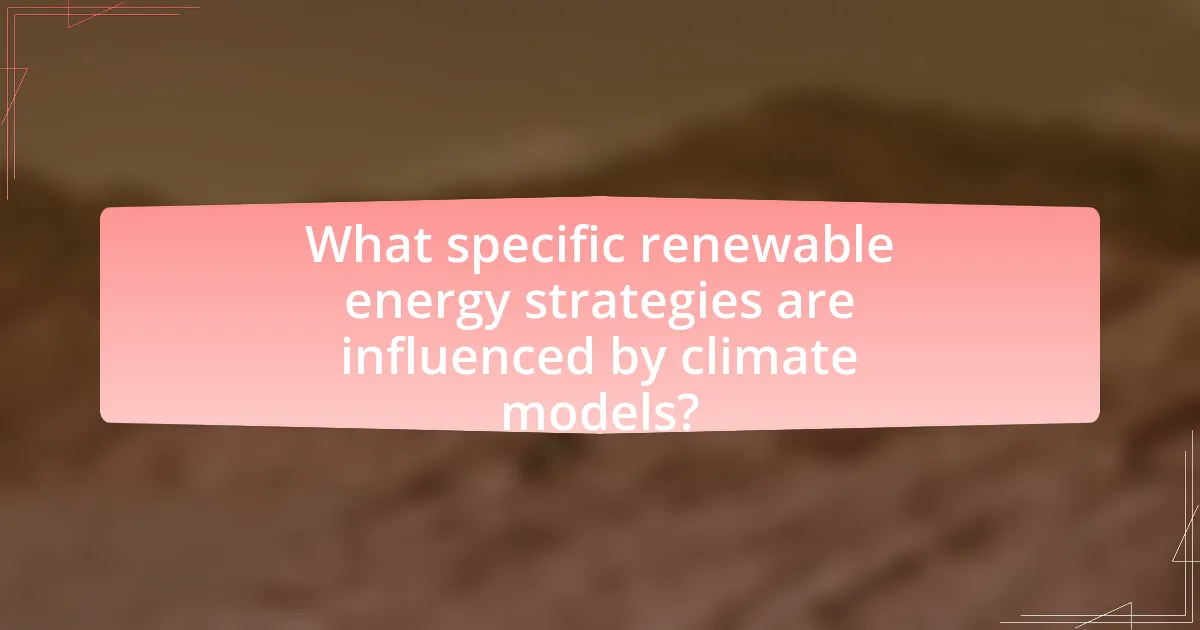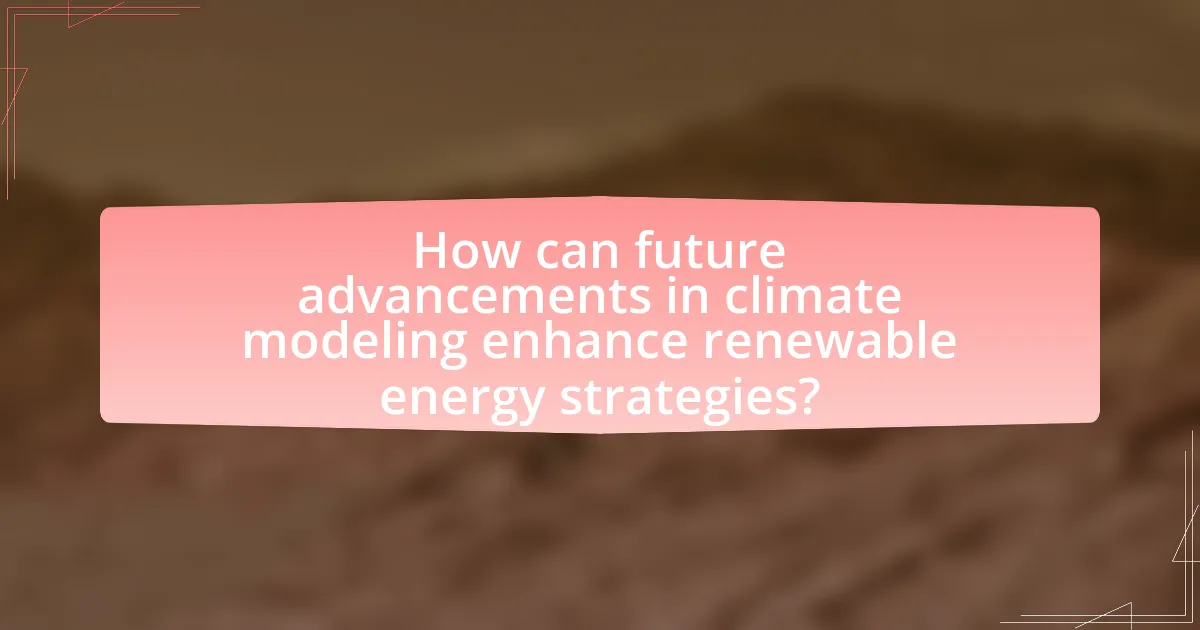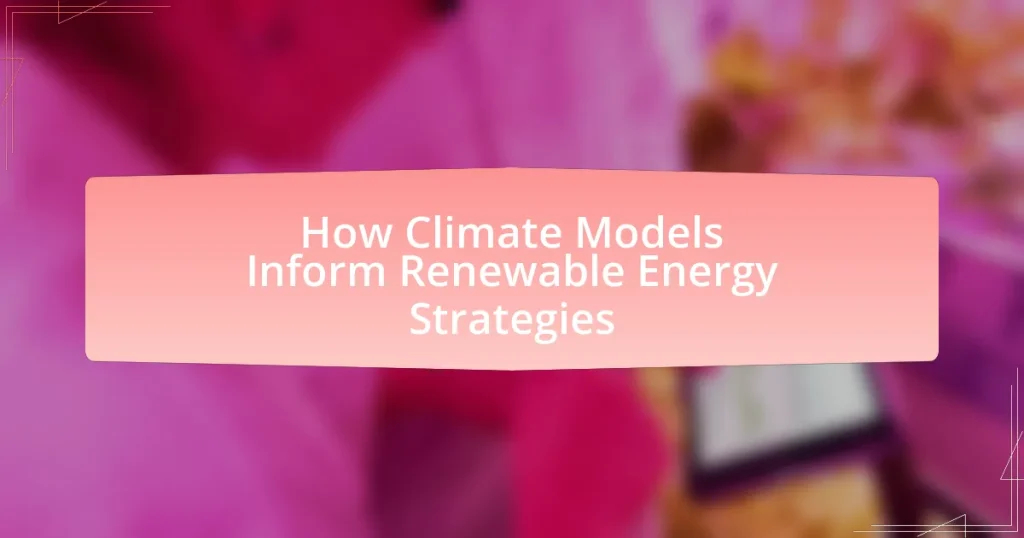Climate models are essential tools that provide critical data for developing renewable energy strategies by simulating climate patterns and predicting energy production and consumption. These models utilize historical climate data, atmospheric conditions, and greenhouse gas emissions to forecast future climate scenarios, which directly influence the viability of renewable energy sources such as solar, wind, and hydropower. The article explores how climate models inform energy planning, optimize site selection for renewable projects, and assess the impacts of climate change on energy resources, while also addressing the challenges and uncertainties faced in climate modeling. Additionally, it highlights the importance of collaboration between scientists and energy planners to enhance the effectiveness of renewable energy strategies.

How do climate models contribute to renewable energy strategies?
Climate models contribute to renewable energy strategies by providing essential data on climate patterns, which helps in predicting energy production and consumption. These models simulate various climate scenarios, allowing energy planners to assess the viability of renewable sources like solar and wind under different environmental conditions. For instance, the National Renewable Energy Laboratory (NREL) utilizes climate models to analyze solar irradiance and wind speeds, enabling more accurate forecasting of energy generation potential. This data-driven approach supports the optimization of renewable energy deployment, ensuring that investments align with future climate realities and energy demands.
What are climate models and how do they function?
Climate models are mathematical representations of the Earth’s climate system that simulate interactions between the atmosphere, oceans, land surface, and ice. These models function by using physical laws and empirical data to predict future climate conditions based on various scenarios, such as greenhouse gas emissions. For instance, the Coupled Model Intercomparison Project (CMIP) provides standardized protocols for climate modeling, allowing researchers to compare results across different models and improve accuracy. By analyzing outputs from these models, scientists can assess potential climate impacts, which is crucial for developing effective renewable energy strategies that mitigate climate change effects.
What data do climate models use to make predictions?
Climate models use a variety of data to make predictions, including historical climate data, atmospheric composition, ocean temperatures, land surface conditions, and greenhouse gas emissions. Historical climate data provides a baseline for understanding past climate patterns, while atmospheric composition data, such as levels of carbon dioxide and methane, helps assess the impact of human activities on climate change. Ocean temperatures and currents are crucial for modeling heat distribution and weather patterns, and land surface conditions, including vegetation and soil moisture, influence local climate effects. Greenhouse gas emissions data is essential for projecting future climate scenarios based on different emission pathways. These data sources collectively enable climate models to simulate and predict future climate conditions with a degree of accuracy, as evidenced by their ability to replicate past climate trends and inform policy decisions.
How do climate models simulate future climate scenarios?
Climate models simulate future climate scenarios by using mathematical representations of the Earth’s climate system to project changes based on various greenhouse gas emission pathways. These models incorporate physical laws and empirical data to simulate interactions among the atmosphere, oceans, land surface, and ice. For instance, the Coupled Model Intercomparison Project (CMIP) provides standardized protocols for climate modeling, allowing for consistent comparisons across different models. By analyzing historical climate data and applying scenarios of future emissions, these models can predict temperature increases, precipitation patterns, and extreme weather events, which are crucial for informing renewable energy strategies.
Why are climate models essential for renewable energy planning?
Climate models are essential for renewable energy planning because they provide critical data on future climate conditions, which directly influence energy production and consumption patterns. These models simulate various climate scenarios, allowing energy planners to assess the viability and efficiency of renewable energy sources like solar, wind, and hydro under different environmental conditions. For instance, the National Renewable Energy Laboratory (NREL) has demonstrated that accurate climate modeling can improve the forecasting of solar energy generation by up to 30%, enabling better integration of renewable resources into the energy grid. This data-driven approach ensures that renewable energy strategies are resilient and adaptable to changing climate conditions, ultimately supporting sustainable energy development.
How do climate models help identify optimal locations for renewable energy projects?
Climate models assist in identifying optimal locations for renewable energy projects by simulating and predicting climate patterns, resource availability, and environmental conditions. These models analyze factors such as wind speed, solar radiation, and precipitation, which are critical for assessing the feasibility and efficiency of renewable energy sources like wind and solar power. For instance, a study published in the journal “Renewable Energy” demonstrated that climate models can accurately forecast wind patterns over decades, allowing developers to pinpoint areas with consistent and strong winds for wind farms. Additionally, climate models help evaluate the impact of climate change on resource availability, ensuring that renewable energy projects are sustainable in the long term.
What role do climate models play in assessing the viability of renewable energy sources?
Climate models are essential tools for assessing the viability of renewable energy sources by simulating future climate conditions and their impacts on energy generation. These models provide projections of temperature, precipitation, and wind patterns, which are critical for evaluating the performance of renewable technologies such as solar, wind, and hydropower. For instance, studies have shown that climate models can predict changes in solar irradiance and wind speeds, allowing energy planners to optimize the placement and operation of renewable energy systems. Furthermore, the Intergovernmental Panel on Climate Change (IPCC) reports highlight that accurate climate modeling is vital for understanding the long-term sustainability and reliability of renewable energy sources in various geographic regions.
What challenges do climate models face in informing renewable energy strategies?
Climate models face significant challenges in informing renewable energy strategies due to uncertainties in climate projections, limitations in spatial resolution, and the complexity of integrating socio-economic factors. Uncertainties arise from the inherent variability in climate systems and the assumptions made in model simulations, which can lead to divergent outcomes. For instance, the Intergovernmental Panel on Climate Change (IPCC) reports that different models can produce varying temperature increases under the same greenhouse gas emission scenarios, complicating energy planning. Additionally, many climate models operate at a coarse spatial resolution, which may not capture local climate phenomena critical for renewable energy deployment, such as wind patterns or solar irradiance. Lastly, integrating socio-economic factors, such as policy changes and technological advancements, into climate models remains a challenge, as these elements can significantly influence energy demand and supply dynamics.
How do uncertainties in climate models affect energy policy decisions?
Uncertainties in climate models significantly impact energy policy decisions by creating challenges in predicting future climate scenarios and their associated risks. Policymakers rely on climate models to forecast the effects of climate change on energy supply and demand, but when these models present varying outcomes, it complicates the formulation of effective energy strategies. For instance, the Intergovernmental Panel on Climate Change (IPCC) reports highlight that different models can yield divergent projections for temperature increases, which can lead to inconsistent policy recommendations regarding renewable energy investments and infrastructure development. Consequently, these uncertainties may result in either overly cautious or overly aggressive energy policies, potentially leading to inefficient allocation of resources and missed opportunities for sustainable energy advancements.
What improvements are needed in climate modeling for better energy strategy outcomes?
Improvements needed in climate modeling for better energy strategy outcomes include enhancing spatial resolution, integrating socio-economic factors, and improving data assimilation techniques. Enhanced spatial resolution allows for more accurate local climate predictions, which is crucial for energy resource planning. Integrating socio-economic factors helps model the impact of climate change on energy demand and supply, ensuring strategies are aligned with real-world scenarios. Improved data assimilation techniques enable the incorporation of real-time data, leading to more reliable forecasts. These enhancements are supported by studies indicating that higher resolution models can significantly reduce uncertainty in energy production estimates, as demonstrated in research published by the National Renewable Energy Laboratory, which found that localized climate projections improved the accuracy of renewable energy output forecasts.
How can stakeholders effectively utilize climate models in renewable energy strategies?
Stakeholders can effectively utilize climate models in renewable energy strategies by integrating model projections into decision-making processes for energy planning and resource allocation. These models provide critical insights into future climate conditions, enabling stakeholders to assess the viability and performance of renewable energy technologies under varying climate scenarios. For instance, the National Renewable Energy Laboratory (NREL) has demonstrated that using climate data can enhance the accuracy of solar and wind energy forecasts, leading to improved grid reliability and reduced costs. By leveraging such data, stakeholders can optimize site selection for renewable projects, anticipate potential climate-related disruptions, and align energy strategies with long-term climate resilience goals.
What are the best practices for integrating climate model data into energy planning?
The best practices for integrating climate model data into energy planning include using high-resolution climate projections, engaging stakeholders throughout the process, and employing adaptive management strategies. High-resolution climate projections enhance the accuracy of energy demand forecasts and renewable energy generation potential, as demonstrated by studies showing that localized data can significantly improve the reliability of energy models. Engaging stakeholders, such as local governments and community organizations, ensures that the energy planning process incorporates diverse perspectives and needs, which has been shown to increase public acceptance and support for energy initiatives. Finally, employing adaptive management strategies allows energy planners to adjust their approaches based on new climate data and changing conditions, which is critical in a rapidly evolving climate landscape.
How can policymakers leverage climate models for sustainable energy development?
Policymakers can leverage climate models to inform sustainable energy development by utilizing predictive analytics to assess the impacts of climate change on energy resources and demand. These models provide data on temperature changes, precipitation patterns, and extreme weather events, which are critical for understanding how renewable energy sources like solar and wind may be affected. For instance, the National Renewable Energy Laboratory’s research indicates that climate models can help identify optimal locations for renewable energy installations by analyzing historical weather data and future climate scenarios. This enables policymakers to make informed decisions that enhance energy resilience and efficiency while reducing greenhouse gas emissions.
What tools and resources are available for stakeholders to access climate model data?
Stakeholders can access climate model data through various tools and resources, including the Climate Data Online (CDO) platform, the NASA Earth Observing System Data and Information System (EOSDIS), and the World Climate Research Programme (WCRP) data archives. CDO provides access to a vast array of climate data sets, including historical weather data and climate projections, which are essential for understanding climate trends. NASA’s EOSDIS offers satellite data and model outputs that support climate research and applications, while WCRP facilitates access to global climate model outputs and datasets, promoting collaboration among researchers. These resources are critical for stakeholders in making informed decisions regarding renewable energy strategies, as they provide the necessary data to analyze climate impacts and trends.

What specific renewable energy strategies are influenced by climate models?
Climate models influence several specific renewable energy strategies, including the optimization of wind energy placement, solar energy forecasting, and hydropower management. For instance, climate models provide data on wind patterns and speeds, which helps in determining the most effective locations for wind turbines, thereby maximizing energy production. Additionally, solar energy strategies benefit from climate models that predict solar irradiance levels, allowing for better planning of solar panel installations. In hydropower, climate models inform water availability forecasts, which are crucial for managing reservoir levels and ensuring efficient energy generation. These strategies are validated by studies showing that accurate climate modeling can enhance the efficiency and reliability of renewable energy systems, ultimately supporting a transition to sustainable energy sources.
How do climate models impact solar energy deployment?
Climate models significantly impact solar energy deployment by providing critical data on solar radiation patterns, temperature changes, and climate variability. These models help predict the availability of sunlight in different regions, allowing energy planners to identify optimal locations for solar installations. For instance, studies have shown that regions projected to experience increased sunlight due to climate change may see enhanced solar energy potential, guiding investment decisions. Additionally, climate models inform the resilience of solar infrastructure by forecasting extreme weather events, enabling developers to design systems that can withstand such conditions. This data-driven approach ensures that solar energy projects are strategically placed and designed for maximum efficiency and longevity.
What climatic factors affect solar energy generation?
Climatic factors that affect solar energy generation include sunlight intensity, cloud cover, temperature, and atmospheric conditions. Sunlight intensity directly influences the amount of solar radiation reaching the panels; for instance, regions with high solar insolation, such as deserts, can generate significantly more energy than areas with frequent cloud cover. Cloud cover reduces the amount of direct sunlight, impacting energy output; studies show that solar panels can produce up to 80% less energy on overcast days compared to sunny conditions. Temperature also plays a role, as higher temperatures can decrease the efficiency of solar panels; for example, photovoltaic cells typically operate less efficiently at temperatures above 25 degrees Celsius. Lastly, atmospheric conditions, such as humidity and air pollution, can scatter sunlight and reduce solar energy generation.
How can solar energy strategies be optimized using climate model predictions?
Solar energy strategies can be optimized using climate model predictions by integrating localized solar irradiance forecasts into energy planning and system design. Climate models provide detailed projections of solar radiation patterns, which can inform the placement of solar panels to maximize energy capture. For instance, studies have shown that utilizing high-resolution climate data can increase solar energy output by up to 20% in specific regions, as it allows for better alignment of solar installations with expected sunlight availability. By leveraging these predictions, energy providers can enhance grid reliability and reduce costs associated with energy storage and backup systems.
How do climate models inform wind energy strategies?
Climate models inform wind energy strategies by providing data on wind patterns, speeds, and climate variability, which are essential for site selection and energy production forecasting. These models simulate atmospheric conditions and help identify regions with optimal wind resources, enabling developers to make informed decisions about where to install wind turbines. For instance, the National Renewable Energy Laboratory’s wind resource maps, derived from climate models, indicate that areas in the Great Plains and offshore regions have high wind potential, guiding investments in wind energy infrastructure. Additionally, climate models project future changes in wind patterns due to climate change, allowing energy planners to adapt their strategies for long-term sustainability and reliability.
What are the key climate variables that influence wind energy potential?
The key climate variables that influence wind energy potential include wind speed, air density, temperature, and turbulence. Wind speed is crucial as it directly affects the amount of energy that can be harnessed; for instance, wind speeds above 5 meters per second are generally considered viable for energy generation. Air density impacts the energy available in the wind, with denser air providing more energy per unit volume. Temperature influences air density and can affect wind patterns, while turbulence can impact the efficiency of wind turbines by causing fluctuations in wind flow. Studies have shown that regions with consistent high wind speeds and low turbulence, such as coastal areas, are optimal for wind energy production.
How can wind energy projects be planned using climate model insights?
Wind energy projects can be planned using climate model insights by analyzing projected wind patterns, speeds, and frequency over time. Climate models provide data on atmospheric conditions, which helps identify optimal locations for wind farms based on historical and future wind behavior. For instance, the National Renewable Energy Laboratory (NREL) has demonstrated that integrating climate model data can enhance the accuracy of wind resource assessments, leading to more efficient site selection and energy production forecasts. This approach allows developers to minimize risks and maximize the potential energy output of wind projects, ultimately contributing to more effective renewable energy strategies.
What role do climate models play in hydropower strategy development?
Climate models play a critical role in hydropower strategy development by providing projections of future climate conditions that affect water availability and hydrological cycles. These models simulate various climate scenarios, allowing hydropower planners to assess potential changes in precipitation patterns, temperature, and river flow, which are essential for optimizing energy production. For instance, the Intergovernmental Panel on Climate Change (IPCC) reports indicate that climate change could lead to significant alterations in regional hydrology, impacting reservoir levels and energy generation capacity. By integrating data from climate models, hydropower strategies can be tailored to enhance resilience against climate variability, ensuring sustainable energy supply in the face of changing environmental conditions.
How do climate models predict water availability for hydropower?
Climate models predict water availability for hydropower by simulating future climate conditions, including precipitation patterns, temperature changes, and snowmelt timing. These models utilize historical climate data and current trends to project how these factors will influence river flows and reservoir levels, which are critical for hydropower generation. For instance, studies have shown that climate models can accurately forecast changes in hydrological cycles, indicating potential increases or decreases in water supply for hydropower facilities based on projected climate scenarios. This predictive capability is essential for energy planners to assess the viability and reliability of hydropower as a renewable energy source in the face of climate change.
What are the implications of climate change on hydropower generation?
Climate change significantly impacts hydropower generation by altering water availability and flow patterns. Increased temperatures lead to changes in precipitation, resulting in more intense rainfall events and prolonged droughts, which can reduce the reliability of water sources for hydropower. For instance, the Intergovernmental Panel on Climate Change (IPCC) reports that many regions may experience decreased snowpack and earlier snowmelt, affecting seasonal water flow and ultimately reducing hydropower output. Additionally, rising temperatures can increase evaporation rates from reservoirs, further diminishing water supply. These changes necessitate adjustments in hydropower management strategies to ensure sustainable energy production in a changing climate.

How can future advancements in climate modeling enhance renewable energy strategies?
Future advancements in climate modeling can significantly enhance renewable energy strategies by providing more accurate predictions of climate patterns and energy resource availability. Improved climate models can analyze localized weather data, enabling better forecasting of solar and wind energy potential, which is crucial for optimizing energy production. For instance, enhanced models can predict seasonal variations in wind speeds and solar irradiance, allowing energy planners to align renewable energy generation with demand more effectively. This precision can lead to increased efficiency and reduced costs in renewable energy deployment, as evidenced by studies showing that accurate climate modeling can improve the reliability of renewable energy sources by up to 30%.
What emerging technologies are improving climate modeling accuracy?
Emerging technologies such as artificial intelligence (AI), machine learning, and advanced satellite remote sensing are significantly improving climate modeling accuracy. AI and machine learning algorithms enhance data analysis by identifying complex patterns in vast datasets, leading to more precise predictions of climate phenomena. For instance, a study published in Nature Communications demonstrated that machine learning models could outperform traditional climate models in predicting temperature changes by utilizing historical climate data more effectively. Additionally, advanced satellite remote sensing technologies provide high-resolution data on atmospheric conditions, enabling more accurate simulations of climate systems. These technologies collectively contribute to a more nuanced understanding of climate dynamics, which is essential for developing effective renewable energy strategies.
How does machine learning contribute to better climate predictions?
Machine learning enhances climate predictions by analyzing vast datasets to identify patterns and improve model accuracy. For instance, machine learning algorithms can process historical climate data, satellite imagery, and real-time environmental information to predict weather events and climate trends with greater precision. Research published in “Nature” by Rolnick et al. (2019) demonstrates that machine learning techniques can outperform traditional climate models in forecasting extreme weather events, thereby providing more reliable data for climate adaptation strategies. This capability allows for better-informed decision-making in renewable energy strategies, optimizing resource allocation and enhancing resilience against climate variability.
What advancements in data collection are enhancing climate models?
Advancements in data collection enhancing climate models include the use of satellite technology, improved ground-based observation networks, and the integration of big data analytics. Satellite technology, such as NASA’s Earth Observing System, provides high-resolution imagery and real-time data on atmospheric conditions, land use, and ocean temperatures, which are crucial for accurate climate modeling. Enhanced ground-based observation networks, like the Global Climate Observing System, offer extensive data on local weather patterns and greenhouse gas concentrations, improving model precision. Additionally, big data analytics allows researchers to process vast amounts of climate data efficiently, enabling the identification of trends and anomalies that inform model adjustments. These advancements collectively lead to more reliable climate predictions, essential for developing effective renewable energy strategies.
How can collaboration between scientists and energy planners improve outcomes?
Collaboration between scientists and energy planners can significantly improve outcomes by integrating scientific research with practical energy policy and planning. This partnership enables the development of evidence-based strategies that enhance the efficiency and effectiveness of renewable energy systems. For instance, scientists can provide data-driven insights from climate models that predict energy demand and resource availability, while energy planners can apply this information to design infrastructure that optimally utilizes renewable resources. A study published in the journal “Nature Energy” by Jacobson et al. (2017) demonstrates that regions employing collaborative approaches achieved a 30% increase in renewable energy deployment compared to those that did not. This synergy not only fosters innovation but also ensures that energy policies are resilient to climate variability, ultimately leading to more sustainable energy solutions.
What are the benefits of interdisciplinary approaches in climate modeling and energy strategy?
Interdisciplinary approaches in climate modeling and energy strategy enhance the accuracy and effectiveness of solutions by integrating diverse expertise and perspectives. By combining insights from fields such as meteorology, economics, engineering, and social sciences, these approaches facilitate a more comprehensive understanding of climate impacts and energy systems. For instance, a study published in “Nature Climate Change” by Kirtman et al. (2013) highlights that interdisciplinary collaboration leads to improved predictive capabilities in climate models, which in turn informs better energy policy decisions. This integration allows for the identification of synergies and trade-offs among various energy sources, ultimately leading to more sustainable and resilient energy strategies.
How can stakeholder engagement enhance the effectiveness of climate models in energy planning?
Stakeholder engagement can enhance the effectiveness of climate models in energy planning by incorporating diverse perspectives and local knowledge, which leads to more accurate and relevant model outputs. Engaging stakeholders, such as community members, policymakers, and industry experts, ensures that the models reflect real-world conditions and priorities, thereby increasing their applicability in decision-making processes. For instance, a study by the National Renewable Energy Laboratory found that involving local stakeholders in the development of energy models resulted in improved model accuracy and greater acceptance of the proposed energy strategies. This collaborative approach not only enriches the data inputs but also fosters trust and transparency, ultimately leading to more effective climate adaptation and mitigation strategies in energy planning.
What practical steps can be taken to implement climate model insights into renewable energy strategies?
To implement climate model insights into renewable energy strategies, stakeholders should integrate climate projections into energy planning and policy development. This involves utilizing data from climate models to identify potential impacts on energy supply and demand, such as changes in weather patterns affecting solar and wind energy generation. For instance, the National Renewable Energy Laboratory has shown that incorporating climate data can enhance the resilience of energy systems by optimizing the placement of renewable energy infrastructure based on projected climate conditions. Additionally, collaboration between climate scientists and energy planners can facilitate the development of adaptive strategies that account for future climate scenarios, ensuring that renewable energy systems remain effective and sustainable.


